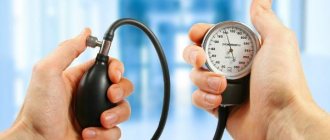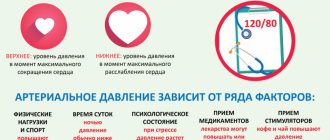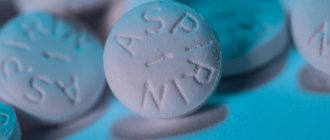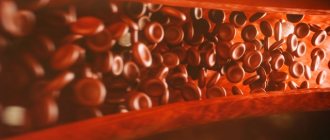What does pressure 160 to 80 mean? How to lower it
In addition to massage, there are a number of activities that will help a person bring blood pressure back to normal. These include:
- Physical exercise. They are quite simple. They can be performed by a person without special physical training.
- Compresses or baths. These products are used on the patient's legs. This method of treatment can bring a person back to normal. To apply compresses, you need to take a cloth napkin. Soak it in vinegar. Next, the napkin is applied to the feet and fixed. The application time of the compress is 5 minutes.
- A shower is suitable to stabilize the pressure. Under no circumstances should you take it hot. The water should be warm. The back of a person's head is massaged using a shower. This procedure can stabilize the patient's condition. Taking a bath with a pressure of 160 to 80 is not recommended, as the person’s condition may worsen.
- Baths for hands. This procedure is also recommended to be carried out in warm water. It is necessary to pour water into the container, the temperature of which is 37 degrees. Next you need to put your hands in it. They must be left in water for 10 minutes. When the liquid cools, it is recommended to add warm liquid to the container in which the procedure is being carried out. It is necessary to ensure that the water temperature does not exceed 42 degrees.
We found out why the pressure becomes 160*100. What to do? How to keep it under control? A patient who is prone to high blood pressure needs to monitor his diet. Namely, you should avoid eating foods that contain large amounts of fat. You can consume dairy products such as cottage cheese and sour cream. But it’s also worth keeping an eye on their fat content. It is better to buy dairy products with the lowest fat content.
What pills can you take?
In case of a single attack of hypertension, it is advisable to try to reduce high blood pressure without the help of any medications at all. If it does not subside, you should first take medications based on natural ingredients. These include tablets based on motherwort extract and valerian. You can try a tincture of the same herbs. It is worth remembering that blood pressure will decrease gradually. If the result is not achieved a couple of hours after taking the drug, you can take it again.
Also, if high blood pressure is accompanied by headaches and dizziness, you can take Citramon and similar drugs. They do not bring down the indicators, but help get rid of the unpleasant symptoms of this condition.
Sometimes they are also advised to take Aspirin, one of the side effects of which is a decrease in blood pressure. However, this should be done if nothing else from home remedies helps, there is a severe headache.
In addition, various herbal infusions help against high blood pressure. For hypertension, it is recommended to brew chamomile, mint, linden, rose hips, and sage. They can be used separately or added to tea. However, sugar should not be added to drinks; it can further increase the values. In this case, it will be useful to drink weak tea with lemon.
Why is there such pressure?
Blood pressure increases for a variety of reasons, both due to negative external factors and the development of concomitant diseases. It can be:
- Cardiovascular diseases.
- Endocrine disorders - pathologies of the thyroid gland, adrenal glands, diabetes mellitus.
- Frequent stress, nervous tension, emotional overload - a severe stressful situation can cause a short-term increase in blood pressure, but if a person is constantly in this state, changes in pressure lead to the development of hypertension.
- Insufficient physical activity - it is foolish to expect that you will maintain a toned figure and excellent health while sitting at work all day and not leaving home on weekends.
- Advanced age.
- Poor nutrition - the first thing that negatively affects the condition of blood vessels is the consumption of salty and fatty foods. With food, the body enters an excess amount of table salt and saturated fatty acids. Cholesterol is found in large quantities in sausages, fatty dairy products, chocolate, and baked goods.
- Addictions - first of all, we are talking about smoking, and, of course, about too frequent parties, birthdays and other events that do not involve alcoholic beverages.
Despite the fact that a pressure of 160/90 may not cause noticeable discomfort, at this value the heart function is disrupted, the functioning of the kidneys is disrupted, and the endocrine glands are affected. If you feel slight nausea, dizziness and headache, go to the doctor, who will be able to identify hypertension in a timely manner and prescribe treatment that will help prevent the development of serious diseases.
How to prevent further development of hypertension
Stage 1 is not stable, and the limits of fluctuations in the mercury column data cannot always be fixed, but they rarely exceed the boundaries of 160/90. The second stage is expressed by crises, while the pressure lingers for a long time at values of 170/100 or even 200/110. We will tell you what to do if the pressure is 170 over 100 or higher, but it is necessary to understand that with regularly observed numbers of this magnitude, it is not always possible to reverse the disease.
A short conclusion: in the case of complete exclusion of external provoking factors, systematically observed readings above 150/90 (which means a pressure of 170 over 100) can be considered a sign of hypertension.
- Get outside as often as possible - go cycling, walk, visit outdoor pools.
- Limit your salt intake. If possible, exclude it from your diet.
- Replace 70% of your usual food with foods containing coarse fiber, natural carbohydrates, and complete protein.
- Do not retain harmful substances in the body - monitor the regularity of bowel movements.
Medicines that normalize high blood pressure include:
- diuretics, including arifon, furosemide, indapamide, hypothiazide;
- angiotensin-2 inhibitors, for example, lisinopril, enalopril, captopril;
- calcium antagonists, including amlodipine, verapamil, nifedipine;
- beta blockers, for example bisoprolol, metoprolol.
The medicine is individually selected by the attending physician. You should know that diuretics (diuretics) flush potassium and magnesium from the body. Therefore, they additionally take panangin or include dried apricots and raisins in their diet.
It is necessary to give up alcohol and smoking. Reduce weight to normal. Moderate physical activity, fresh air, and a healthy diet are necessary. It is necessary to limit the consumption of salt, fatty, smoked, spicy foods. Normalize sleep and try to avoid stress and anxiety.
Symptoms and treatment of arterial hypertension
In the modern world, the percentage of people who have diseases of the cardiovascular system is quite large. Mortality from these diseases ranks high. Very often, problems begin with a slight increase in blood pressure, which many people do not pay attention to. Over time this...
How to normalize blood pressure at home
Since a slight increase in pressure is easier to bring to a normal level, it is important to know measures that will help improve the patient’s condition without seeking medical help. The first thing you can do is take a foot bath with water at room temperature.
As an alternative, you can also use water compresses that are applied to the soles of your feet.
If blood pressure levels increase, a contrast shower will also alleviate the condition, but it is important that it is not hot under any circumstances. During the water procedure, you can also lightly massage the back of your head. But you can’t take a bath if your blood pressure is high, this will only worsen your general condition.
Hand baths have a weaker hypotensive effect. To take them, you should prepare water that will correspond to body temperature, then lower your hands into the container and hold for 10 minutes.
The benefits of massage for hypertension
Treatment of hypertension involves not only drug therapy. In some cases, various alternative activities, such as massage, will be helpful. We have had to deal with this procedure since childhood, as it helps to improve the health of the body and improve overall well-being.
Benefits of massage for hypertension:
- Improving the functioning of the cardiovascular system;
- Normalization of metabolism;
- Relieving muscle and vascular tone;
- Increased adaptability to physical activity.
In addition to treating arterial hypertension, massage will be indicated for neuroses, vegetative-vascular dystonia, cardiosclerosis and myocardial dystrophy. Physiotherapeutic procedures provide a good therapeutic effect for vascular atherosclerosis and dysfunction of the vestibular apparatus. But, despite all the benefits, massage should be performed by a qualified specialist so as not to cause harm.
What tea will help normalize blood pressure of 160 to 80 mm Hg? Art.
Teas have long been known for their tonic and healing effects. Numerous recipes and components help make this drink also tasty.
As an addition to the main treatment, you can drink tea for therapeutic purposes.
The healthiest drinks:
- Hibiscus is known to everyone for its sour taste. It is often brewed in the summer because it quenches thirst well. Tea is effective in the fight against hypertension because it improves metabolism and normalizes blood circulation. The numerous vitamin composition provides a pronounced antioxidant effect.
- Many people use green tea as an antihypertensive drug, but few people know what provides the therapeutic effect. Green tea contains the amino acid theanine, which increases the synthesis of the neurotransmitter GABA in the brain. This compound, in turn, improves vascular function and has a sedative effect.
- Peppermint tea helps lower blood pressure due to its high content of essential oils and in particular menthol. This chemical has an analgesic and relaxing effect, and also helps cope with inflammatory processes. To lower blood pressure, just brew a few leaves of the plant. You can also use a mixture of several types of tea.
A single increase in pressure does not pose a particular threat to the body. If the upper indicator increases systematically, then we can say that the patient is faced with the initial stage of hypertension. That is why it is important at this stage to take measures to prevent the progression of the disease. In this case, the complex of treatment measures will be individual in each case.
Blood pressure 150 to 110
Regulation of normal blood pressure levels is carried out by the autonomic nervous system, due to the activation of compensatory mechanisms. So, the optimal blood pressure (blood pressure) indicators are 120/80 mm. rt. Art.
A slight deviation from the norm can be observed as a result of physiological processes as a consequence of excessive emotional and mental stress, as well as after taking certain medications.
However, a significant and constant increase in tonometer values indicates the development of pathological conditions in the body that are not amenable to regulatory mechanisms.
A pressure of 150 to 110 is a sign of the initial stage of arterial hypertension, which requires urgent drug correction. What causes this disorder and what methods exist to correct it?
What does blood pressure 150/110 mean?
A pressure of 150 over 110 is not normal and in most cases signals the formation of the initial stage of arterial hypertension.
A one-time deviation from normal values does not indicate the formation of pathology, since a temporary increase can occur as a result of excessive intake of salty foods, or an overdose of alcoholic beverages and medications.
The diagnosis is established based on the systematic identification of abnormalities, when high values are recorded for 14 days, with episodes 2 to 3 times a week.
Classification of hypertension by blood pressure level
In most cases, blood pressure readings of 150/110 are considered a mild form of arterial hypertension. However, upon closer examination, the systolic indicator corresponds to the first stage of the disease, and the diastolic indicator indicates the transition of the pathology from the second to the third stage.
This discrepancy between the lower value and the criteria may indicate a high peripheral resistance tone, as well as tension in the vascular walls during the period of myocardial relaxation.
A violation may indicate the development of symptomatic (secondary) hypertension against the background of other organs involved in the regulation of blood pressure.
Main reasons for development
Symptomatic hypertension is observed in chronic diseases of the kidneys, thyroid gland, blood vessels and myocardium.
The predominant increase in diastolic indicator is associated with high arterial spastic activity that occurs when the following organs are affected:
What to do if the pressure is 150 to 70
- Dysfunction of the periglomerular apparatus.
Causes excess production of biologically active substances that provoke vascular spasm. As a result of the influence of vasospastic hormones, the tone of the smooth muscles of the arteries increases and the vascular lumen decreases. These pathologies include (glomerulonephritis, atherosclerosis of the renal vessels, nephropathy). - Excessive production of thyroid hormones.
The production of large amounts of thyroid-stimulating hormones provokes pronounced activity of the sympathetic nervous system. This serves as a provocateur of afferent stimulation of the vascular center in the medulla oblongata, which is expressed in the formation of arterial spasm. - Increased circulating blood volume.
It is observed when the activity of the renal tissue is impaired, when sodium and fluid retention occurs. It is registered against the background of endocrine dysfunction, manifested by fluid retention, which leads to hypervolemia.
An increase in blood pressure values against the background of cardiac and vascular pathologies is referred to as hemodynamic secondary hypertension.
Its formation is caused by atherosclerotic processes in the aorta, some heart valve defects, chronic heart failure, and severe disorders of myocardial contractile activity. Atherosclerotic damage to regional vessels leads to a disorder of the heart rhythm, as a result of which the myocardium does not relax enough in the diastole phase.
Provoking factors include:
- genetic predisposition;
- men over 40 years of age;
- women over 50 years of age;
- lipid and carbohydrate metabolism disorders;
- excess body weight;
- excessive consumption of sodium chloride;
- sedentary lifestyle;
- bad habits;
- low resistance to stress.
Kidney factor
The kidneys ensure the maintenance of normal blood pressure levels. When they are damaged, pressure levels increase, and they are also the target organ for essential hypertension. Secondary hypertension of renal origin is associated with damage to the vessels of the organ; thus, renovascular and renoparenchymal forms are distinguished.
With the renovascular form, the pressure of blood flowing into the vessels of the kidneys decreases, as a result of which mechanisms aimed at restoring blood circulation are activated, which leads to excess production of renin.
This provokes an increase in vascular tone, their spasm, as a result of which the pressure level increases.
In the clinical picture, the disease is manifested by an increase in the predominantly diastolic indicator, resistant to antihypertensive therapy.
Renoparenchymal hypertension is the most common type of pathology, developing as a result of chronic glomerulonephritis, pyelonephritis, and infection of the excretory system. In the clinical picture, high blood pressure is combined with characteristic renal symptoms such as swelling, pain in the lumbar region, and urinary disorders.
Important! A pressure of 150 to 120 may correspond to the renal form of the pathology, when the diastolic value increases significantly, and endocrine metabolic disorders provoke a proportional increase in the systolic value.
The symptoms of symptomatic hypertension depend on the disease that caused the increase in tonometer values. The main symptom is a persistent increase in blood pressure, which is difficult to respond to drug therapy.
The following symptoms of the disease are distinguished:
- constant headache;
- noises in the head;
- pain in the occipital area;
- cardiopalmus;
- chest pain;
- flashing “flies” before the eyes;
- increasing weakness;
- swelling.
The absence of clinical manifestations entails gradual progression of the pathological process, which leads to damage to the functional activity of target organs.
Causes of systolic hypertension
The main reasons causing the development of first degree systolic hypertension are:
- Not a rational diet. Excess salt, present in many fast food products, leads to an increase in the amount of fluid in the body, and therefore to an increase in blood pressure.
- Increase in body weight. The greater the body weight, the greater the volume of blood required for its proper nutrition. For the normal functioning of the circulatory system, it is necessary to dilate the arteries, which is impossible under these conditions, since their walls have lost their elasticity and flexibility.
- Lack of potassium and magnesium. A deficiency of essential vitamins and nutrients adversely affects health. But a lack of potassium and magnesium can lead to hypertension, since the first helps normalize water-salt metabolism, and the second helps strengthen the walls of blood vessels.
- Sedentary lifestyle. The predominance of a sedentary lifestyle over sports activities negatively affects the tone of the arteries. Therefore, in critical situations they are not able to react adequately.
- Bad habits. Smoking and alcohol, especially common among men, increase the risk of blood clots in blood vessels, reduce their elasticity and prevent stretching with an increase in blood volume.
In addition, people at risk of developing systolic hypertension include people exposed to frequent stress and living in places with unfavorable environmental conditions.
Systolic hypertension can be caused by severe diseases that affect the body. These include diabetes mellitus, kidney failure, and liver failure.
What are they talking about 16090
As already mentioned, such a blood pressure indicator does not indicate health and normality, but the initial stage of hypertension. Doctors also call this condition fairly moderate hypertension.
Blood pressure of 160/90 is elevated and is characteristic of the 1st degree of hypertension. The likelihood of the disorder occurring is especially high in obese women after the age of forty.
In some cases, such blood pressure can be regarded as normal. Even a pressure of 160 over 100 in men in the age group from forty to fifty years is acceptable if the person does not experience painful symptoms of hypertension. This is especially true for those who boast tall stature and a strong physique - their normal blood pressure is, in principle, slightly higher. In old age, pathology is due to the fact that the aging process affects all systems of the body, and at the same time there is a natural increase in blood pressure levels. The main thing in such cases is to monitor your well-being, regularly visit a cardiologist and, preferably, get a tonometer and independently monitor your blood pressure level.
Women differ from men in having lower blood pressure, so for them 160/90 is always a sign of hypertension at any age. Therefore, even if painful symptoms do not appear and discomfort is not felt, if you discover such a phenomenon in yourself, you should immediately consult a doctor. Increased blood pressure is also often observed during pregnancy, especially during the last trimester. This is explained by the fact that the amount of blood in the mother’s body increases, the heart works with increased load, and the growing child needs oxygen and nutrients. The woman’s pulse rate and blood pressure increase, but normally no more than 140/90.
What do we have to do
In parallel with drug therapy, the patient requires lifestyle and nutrition adjustments.
The most effective for normalizing blood pressure are the following recommendations from doctors:
- Limit salt in your diet. To do this, you should not add salt to dishes during their preparation. It is better to do this before eating. You should also avoid eating salted fish, caviar and other foods high in salt.
- Enrich the menu with vegetables and fruits, herbs, boiled fish and meat. Moreover, dried fruits and decoctions from them will be very useful.
- Avoid eating fried and fatty foods. Semi-finished products, smoked foods, and hard-to-digest foods are strictly prohibited.
- Avoid stress and anxiety. It is also worth getting a full eight hours of sleep.
- Protect yourself from physical stress. At the same time, light sports and long walks in the fresh air will be very useful for a person.
- Completely give up bad habits, be it smoking or drinking alcohol.
- Treat those diseases that can cause high blood pressure.
- Practice hardening. To do this, you can rub down with a cold towel or perform a contrast shower. People with heart disease should temper with caution.
- Maintain your weight at normal levels. If this problem already exists, a person needs to contact a nutritionist who will select an individual nutrition plan for him.
- Control your condition with medications prescribed by your doctor.
Blood pressure readings of 160 to 90 are significantly higher than normal. In such a condition, a person is advised to consult a doctor as soon as possible, get diagnosed and begin treatment. With timely treatment, the patient has every chance of normalizing his health.
It is important to know! No more shortness of breath, headaches, pressure surges and other symptoms of HYPERTENSION! Our readers are already using Leo Bokeria’s method to treat blood pressure. Learn the method...
In terms of insidiousness and severity of developing complications, hypertension ranks first among cardiovascular diseases. It is believed that normal blood pressure should be 120 over 70 or 80, but such a situation, especially in the case of an ordinary person, and not some astronaut, is already in the realm of science fiction. But, if you look at the question a little more softly, an increase in blood pressure to 140/90 is acceptable, however, such values should be alarming, indicating a high probability of hypertension.
If the blood pressure exceeds 140/90, this is a clear reason to diagnose hypertension. With the 1st degree of development of the pathology, the pressure ranges from 140/90 to 160/100 units.
In this case, the greatest negative impact is on the internal target organs:
- The heart is an organ that works in an intense mode, as a result of which hypertrophy of the left ventricle develops and disruption of the functioning of the aortic valve. Outwardly, this is manifested by attacks of tachycardia, which occurs with minimal physical exertion and shortness of breath.
- Brain - poor circulation, vasoconstriction causes a lack of oxygen supply to the brain, resulting in hypoxia. A person suffers from headaches, dizziness, nausea.
- Blood vessels - spastic compression of blood vessels occurs, atherosclerotic changes occur in the aorta and other large arterial vessels. Peripheral vessels suffer greatly, which manifests itself in pain in the calf muscles when walking, freezing of the hands and feet, and numbness of the extremities.
- Kidneys - in most people suffering from high blood pressure, renal dysfunction is detected, in particular, failures in the production of the active vasoconstrictor compound renin.
- Fundus vessels - with high blood pressure, a person’s visual acuity and clarity decreases, dark spots appear before the eyes, and “spots” constantly flash.
If the initial stage of hypertension is not diagnosed in time and treated, this is fraught with the development of severe complications - renal and heart failure, cerebrovascular accident, coronary artery disease. Unfortunately, early diagnosis of the pathology is significantly complicated by the fact that the initial stages of the disorder can occur without any painful symptoms. Without feeling any discomfort, a person learns about the problem by chance, visiting a doctor for another reason or undergoing a medical examination. Deterioration in well-being may already indicate a significant development of the disorder, and sometimes even be a harbinger of a hypertensive crisis.
pressure 150 to 110 reasons what to do
Blood or arterial pressure (BP) changes several times per day; its value can be influenced by various factors: mental, physical and mental stress. But in some cases, high blood pressure, having increased once, begins to regularly bother a person, so a figure of 150 to 100 is considered higher than normal and is not very well tolerated by many.
Causes of pressure 150 to 110
The heart is a human pump, with the help of which all body systems are supplied with oxygen through movement through blood vessels. When its chambers contract, pressure is created to push blood into the vessels. In this case, the normal indicators are:
- Upper - systolic ranging from 100 to 130 mm Hg. Art.;
- Lower - diastolic equals from 60 to 80 atmospheres.
If after sleep or during the day without heavy physical or psychological stress, a person experiences blood pressure readings higher than those indicated, then this indicates hypertension, which can be caused by a number of reasons:
- Predisposition. That is, genetic inheritance, it is transmitted in most cases through the female line, but it is not necessary that if someone in the family had hypertension, then his descendants will also suffer from it.
- Body mass. Excess weight has a detrimental effect on all body systems, including the cardiovascular system. At the first signs of high blood pressure, you should give up flour products and salty foods, the latter retain a large amount of fluid in the body and have a detrimental effect on kidney function.
- Constant sitting or lying down. Hypertension is often observed in people whose professions involve mental activity; they, like no one else, have to constantly sit.
- Age. The aging of the body and its significant wear and tear significantly affects all organs and blood vessels, making their walls less elastic and durable.
- Bad habits. In particular, cigarettes cause spasmodic contraction of blood vessels.
- Emotional experiences, stress and frequent lack of sleep.
- Diseases that can cause hypertension. These include diabetes, pyelonephritis, hypothalamus, atherosclerosis and renal failure.
- Pregnancy can affect various organs, including an increase in the load on the blood vessels; the more the fetus grows, the more blood circulation increases and the pulse increases.
- Weather conditions are especially felt by older people.
- Medicines. Some dietary supplements and oral contraceptives increase the current strength.
- Overstrain and mental stress.
Another cause of hypertension is chronic diseases that are associated with the kidneys, heart, and thyroid gland.
Forms of the disease with high blood pressure
If the reading is 150 to 110, serious complications can occur without proper treatment. It can go through several stages:
- First. With it, an increase in pressure occurs due to a number of the above reasons, but chronic diseases do not affect it. Almost 85% of those suffering from hypertension suffer from this form.
- Secondary. It occurs with pronounced symptoms and appears due to chronic diseases of organs such as the thyroid gland, kidneys and adrenal glands. This form occurs in 10% of the population. This form of the disease is more difficult for humans to tolerate than the previous one. You can’t do without a doctor’s advice on regulating blood pressure.
- The third form of this disease is the most severe. At this stage, the heart works under heavy load and wears out very much. People with this form of hypertension complain of irregular heart rhythms, frequent attacks of angina, and they experience heart failure.
If the pressure often begins to reach the limits of 150 to 110 atmospheres, then it is necessary to undergo an examination that will allow you to prescribe the correct treatment. After visiting a therapist you will have to pass:
- Urine and blood;
- Take an ECG;
- Blood for cholesterol and sugar levels.
You will definitely need to visit a neurologist and ophthalmologist; if necessary, you should contact an endocrinologist and cardiologist. Additional studies include: ultrasound, daily blood pressure monitoring, MRI and others.
When visiting a specialist, he asks the patient about his medical history: bad habits, profession, genetics and lifestyle. Based on the information received and tests, he prescribes therapy. In the case of the third stage of the disease, the patient is admitted to the hospital in order to monitor pressure surges in a hospital setting and determine the appropriate treatment.
The first sign of high pressure, reaching 150 to 110 atmospheres, is a headache, which is accompanied by:
- Frequent heartbeat;
- Sleep disturbance;
- Pain in the heart area;
- Nausea and dizziness;
- Chronic fatigue;
- The appearance of black dots before the eyes;
- Vision deteriorates;
- Sudden surges in pressure;
- Shortness of breath and swelling;
- Redness on the skin.
All of the above deviations from the norm are permanent. They can cause complications in the form of: atherosclerosis, pulmonary edema, myocardial infarction, aortic aneurysm and angina.
In the case of a blood pressure of 150 to 110, the following drugs are prescribed:
- Diuretics - diuretics: indapamide, arifon and others, which remove excess fluid, but at the same time can eliminate useful minerals from the body, so their use should be short-term and strictly dosed;
- Adrenergic blockers: metopropol, bisopropol and others, which deactivate adrenaline receptors, while dilating blood vessels, reducing the load on the heart and lowering the pulse;
- ACE inhibitors: ramipril and enalapril, the effect of which is similar to the drugs of the previous group.
There are a number of measures that can be used to reduce blood pressure at home, these include:
- Breathing exercises to normalize breathing;
- Long walks, preferably in the park or on the embankments;
- The massage, which starts from the back, then moves along the neck to the back of the head, while rubbing and stroking the skin, but without pressing on it;
- Compresses, decoctions and tinctures of hawthorn, vinegar and other medicinal products;
- Own protection of yourself from stress and negativity;
- Salt-free diet;
- To refuse from bad habits.
If the pressure rises to 150 to 110 mm Hg. Art. the patient does not need to be hospitalized, but urgent measures should be taken to reduce these indicators.
- Labile arterial hypertension: what is it, causes and consequences of pathology
- What is the danger with a blood pressure of 60 to 40?
- When a person’s blood pressure is 160 over 110, they speak of stage 2 hypertension
- Can a blood pressure of 120 over 100 be considered normal?
Source: //folkmap.ru/krov/davlenie-150-na-110-prichiny-chto-delat/
Ways to cleanse brain vessels
Doctors also have several techniques and know how to clean blood vessels. In a hospital setting, you may be offered the following techniques:
- Extracorporeal hemocorrection is a method in which approximately 200-500 ml of the patient’s blood is taken during the procedure, then using a centrifuge it is separated into plasma and red blood cells. The red blood cell mass is reintroduced, and the plasma is purified from cholesterol. During the next procedure, clean plasma is reinjected and a new portion of blood is taken for purification.
- Drug therapy is a method that uses vitamin C in large doses, vitamin B2, as well as drugs that dissolve cholesterol and dilate blood vessels in the brain.
- Herbal medicine is a method in which a doctor advises using the medicinal properties of plants.
High pressure features
In men and women, blood pressure never rises to 160 over 80 without reason. This is usually caused by some illness or stress. If this condition recurs frequently, the attending physician may diagnose arterial hypertension.
If the pressure has increased only in the first indicator (systolic criterion), then this indicates arterial hypertension of the isolated systolic type. This disease is quite serious. It requires long-term treatment.
Most often, this condition is diagnosed in an elderly person. This is justified by the fact that as we age, the vessels become less flexible. Calcium accumulates in their cavity. This threatens to increase blood pressure. Also, in this condition, dysfunction of the kidneys and heart often occurs.
Important! A blood pressure of 160 over 90 is very dangerous for teenagers. In the absence of timely treatment, the disease can develop into an advanced form, which not only threatens disability, but also increases the likelihood of death.
Moreover, it is known that boys are more susceptible to this type of hypertension than girls.
Systolic hypertension may not manifest itself at all for a long time. The first warning sign should be prolonged insomnia. In such a state, a person sleeps very poorly and can wake up from the slightest rustle.
Another symptom of the disease is headaches, which worsen under stress. They are accompanied by a feeling of heaviness in the temples, as well as an increased pulse (more than 80 beats).
Additional signs of high blood pressure are:
- tinnitus;
- weakness and rapid fatigue of a person;
- increased heart rate;
- irritability;
- dizziness;
- skin redness;
- frequent changes in sweating and chills;
- tendency to edema;
- numbness of the skin.
A person’s blood pressure of 160 over 90 indicates a serious hypertensive disorder.
The following factors can provoke this condition:
- Poor nutrition. Excess salt in the diet, which leads to an increase in the amount of fluid in the body, has a particularly strong effect on increasing blood pressure. Drinking alcohol is also very harmful to blood vessels.
- Weight gain. Studies have found that the greater the body weight, the greater the volume of blood needed to fully nourish the body. For the normal functioning of the circulatory system, the arteries require dilation, which can lead to a loss of their elasticity.
- Acute lack of potassium and other beneficial microelements. In this condition, a person experiences a deterioration in water-salt metabolism, as well as a decrease in the strength of the walls of blood vessels.
- Insufficiently active lifestyle. Lack of sports activity negatively affects the tone of the arteries. That is why, with sudden stress, they simply cannot adequately respond to the load.
- Smoking. It increases the risk of blood clot formation and also reduces the elasticity of blood vessels.
- Living in an unfavorable environmental environment increases the risk of developing hypertension even in young people.
Important! Very often, hypotension develops in people who suffer from severe chronic diseases. Such diseases may include diabetes, kidney failure, and heart disease.
What can cause high blood pressure
If the necessary measures are not taken in time, this condition can threaten the patient with damage to the heart, kidneys, brain and blood vessels.
The patient experiences a disruption in the functioning of the circulatory system, the walls of blood vessels deteriorate, and in the worst case, a stroke or heart attack occurs.
- With a periodic increase in blood pressure up to 160/100 mm Hg. Art. A mild, first stage of the disease is diagnosed. The patient has mild symptoms. The patient requires completion of the main course of treatment.
- Code blood pressure remains stable at levels up to 180/110 mm Hg. Art., the middle, second stage of the disease is diagnosed. Since this condition can last for several years, it is necessary to do a full study and select a medication treatment regimen. This stage is dangerous due to the appearance of an exacerbation in the form of a hypertensive crisis.
- A hypertensive crisis is a momentary sharp increase in blood pressure. In such a situation, you need to do everything to provide emergency assistance, including taking medications and calling emergency doctors.
- If blood pressure is 210/120 (90, 100, 110, 130, 140) mm Hg. Art., severe, third stage of the disease is diagnosed. In this case, a hypertensive crisis can cause complications in the form of heart failure, coronary heart disease, cerebral circulatory disorders, stroke, myocardial infarction.
Blood pressure increases when arterioles narrow their blood vessels. The brain receives information that the blood in the vessels begins to move slowly, which is why the intensity of the blood flow increases. This in turn provokes an increase in blood pressure.
Increased blood pressure, as a rule, does not occur on its own; this condition is caused by certain factors. Usually the appearance of pathology is associated with the development of complications of a serious disease.
Failure of the cardiovascular, endocrine, and musculoskeletal systems can lead to health problems. Social factors can also have a huge impact.
Significant increase in blood pressure to 210/120 mm Hg. Art. occurs in people who do not regularly take prescribed medications or suddenly stop taking them.
The following factors may also be among the reasons:
- Kidney diseases in the form of chronic pyelonephritis, primary glomerulonephritis, tubulointerstitial nephritis;
- Systemic renal disease in the form of lupus erythematosus, vasculitis, scleroderma;
- Renovascular disease in the form of atherosclerosis, polyarthritis nodosa, fibromuscular dysplasia;
- Endocrine disease in the form of pheochromocytoma, Cushing's syndrome, primary hyperaldosteronism;
- Abuse of diet pills;
- Drug use;
- Taking contraceptive medications;
- Spinal cord injury;
- Narrowing of the aorta;
- Preeclampsia and eclampsia;
- Postoperative hypertension.
With high blood pressure, a person always feels weak. There are certain symptoms that indicate that a patient has hypertension.
- The appearance of headaches, migraines;
- Constant ringing in the ears;
- Permanent weakened state;
- The person feels very tired;
- The heart beats faster;
- Hands and feet are always cold;
- Pain is felt in the heart area behind the sternum.
With a sharp jump in blood pressure to 210/110 (lower pressure can be 90, 100, 120, 130, 140) mm Hg. Art. The patient may have black spots flashing in the eyes, blood rushes to the face, a severe headache in the occipital region, noise in the ears and pain in the heart area behind the sternum.
Since the causes of a sharp increase in blood pressure and a sharp jump in blood pressure up to 210/120 mm Hg. Art. can be life-threatening, you need to know what to do in this case in order to urgently help the patient. Otherwise, the risk of hypertensive crisis, heart attack or stroke increases.
A sharp increase in blood pressure requires taking emergency measures to normalize blood pressure, otherwise a hypertensive crisis may occur, a heart attack or stroke may develop.
The first step is to ensure complete rest for the patient and measure pressure using a tonometer. If the readings are above 160/95 mm Hg. Art., you need to call an ambulance.
Ordinary mustard plasters, which are placed on the calf muscles, shoulders and lower part of the neck, will help to quickly reduce blood pressure at home. When these zones begin to warm up, the narrowed vessels dilate, and after 15 minutes the pressure begins to decrease.
Weak black tea, to which lemon juice and a teaspoon of sedum are added, also helps. Berry juice made from lingonberries and cranberries is considered an effective remedy.
A compress with 6% table vinegar can also help. A napkin is generously moistened with the solution and the patient’s feet are placed on it for 20 minutes. Additionally, the solution is rubbed into the temples and back of the head. After 15 minutes, you can measure your blood pressure again.
When the readings increase to 210/120 mmHg. Art. and above give an injection of magnesium sulfate. Nifedipine drops, taken as a single dose of 20 mg, help prevent a hypertensive crisis. It is also recommended to take Andipal half a tablet.
When severe stress leads to a sharp jump in pressure, you need to do everything to calm the nervous system. The patient should take a sedative in the form of tincture of valerian, peony, motherwort or hawthorn, 20 drops each. If your heart hurts, use valerian or Corvalol.
To help a person in a stressful situation, they often use their own bioenergy, with which they can gently and effectively influence the patient’s body. The main thing in this matter is to sincerely and strongly desire to help.
Alternatively, you can use a salt compress to reduce high blood pressure. It is simple to prepare - the salt is wrapped in soft cloth and placed on the back of the head or lumbar region.
After a complete examination and diagnosis, the doctor prescribes a special diet. Additionally, the patient will have to reconsider his lifestyle, start eating right and physically moving more often.
This improves the patient’s general condition and reduces the risk of developing cardiovascular disease.
The main recommendations for hypertension include:
- By reducing your own weight, blood pressure can be normalized.
- It is necessary to give up drinking alcohol and smoking habits.
- It is important to reduce your intake of salty foods and salt as much as possible to 6 grams per day.
- The treatment complex should include the use of vitamins and minerals.
- It is necessary to exclude foods high in cholesterol from the diet and avoid saturated fats.
- Every day you should exercise your body for at least 30 minutes.
- Blood pressure measurements are required regularly twice a day in the mornings and evenings.
By following these simple rules, you can reduce the risk of complications several times. The therapeutic diet is prescribed by a doctor after undergoing a full examination and is adapted to each patient individually.
If the disease is severe and blood pressure remains at 210/120 mm Hg for a long time. Art., treatment is supplemented with regular intake of medications for hypertension. The attending physician selects medications on an individual basis, taking into account the general condition of the patient, the presence of secondary diseases, and test data. Since hypertension is a very dangerous disease, self-medication is strictly prohibited.
For hypertension, your doctor may prescribe the following medications:
- Diuretic drugs can be used alone or in combination with other antihypertensive drugs.
- Diuretics have a diuretic effect and conserve calcium.
- Loop diuretics.
- ACE inhibitors in the form of Fosingopril, Captopril, Ramipril, Enalapril, Lisinopril and so on.
- Angiotensin II receptor blockers in the form of Losartan, Valsartan, Eprosartan.
- Beta blockers in the form of Atenolol, Metoprolol, Propranolol, Timolol, Labetalol, Carvedilol, Acebutolol.
- Vasodilators in the form of Hydralazine, Minoxidil.
- Calcium antagonists in the form of Nifedipine, Amlodilin, Diltiazem, Verapamil.
- Aldosterone antagonists in the form of Spironolactone.
- Alpha-2 agonists in the form of Clonidine, Tenex.
- Renin inhibitors;
- Antihypertensive alpha blockers in the form of Terazolin, Doxazosin.
If there are secondary diseases, the doctor may prescribe special medications.
Also, for hypertension, sanatorium-resort treatment and visiting a physical therapy room are considered an effective method of therapy. An equally popular way is to take a course of herbal medicine.
To stabilize the condition, you can use folk remedies that have been proven over the years. It is recommended to eat fresh apples, viburnum, rose hips, cranberries and hawthorn every day. The fruits are brewed into hot tea or made into a vitamin juice drink.
Honey with pollen is good for lowering blood pressure; the ingredients are used in a ratio of 1 to 1. For a month, you should eat a teaspoon of the product three times a day every day. After this, a break is taken for a week and the course of treatment is repeated.
Alternatively, the pressure is stabilized with a medicine made from honey and walnuts. 100 grams of nuts are mixed with the same volume of honey. This portion should be eaten within one day. The course of treatment is 45 days. The video in this article is intended to help the patient with a sharp jump in blood pressure.
Please note that all information posted on the site is for reference only and
Treatment with folk remedies
Many people with pathologically high blood pressure mistakenly believe that it is impossible to lower it at home. However, it is quite possible to influence your blood pressure without going to a medical facility.
If you don’t have pills on hand or for some reason it’s undesirable to use them, you can quickly reduce high blood pressure with the help of cinnamon and kefir. In one glass of kefir you need to dissolve a small spoon of dry cinnamon and drink the medicinal mixture. This remedy quickly returns the blood pressure to normal. In addition, it can also be used for preventive purposes.
Blood pressure more than 190/60 mmHg. Art. can be quickly knocked down using potato peelings. They need to be boiled in 250 ml of water. Next, the resulting mixture is filtered, cooled and half is drunk. If after some time the pressure rises to 190/60 mm Hg. Art., carry out the procedure again.
Herbal teas are considered a recognized remedy for high blood pressure. In this case, infusions from:
- valerian,
- motherwort,
- cumin.
Birch sap, along with other folk remedies, is considered an effective way to normalize blood pressure. In addition, birch sap has a positive effect on the functioning of the heart and blood vessels.
It should be noted that self-medication at home can be extremely dangerous for your health, so before you opt for treatment at home, you need to talk about it with your doctor.
A simple recipe is considered a stabilizing folk treatment at home: eat several fresh apples daily. Be sure to use at home:
- rose hip,
- viburnum,
- cranberries
Take action!
If you know what factors influenced the increase in pressure to 150 to 110 mmHg. Art., first of all, eliminate them immediately. Next, you should resort to methods of drug correction. Drugs are used that fully meet the requirements for relieving hypertensive crises:
- Calcium channel blockers - Nifedipine. Recommended sublingual dose is 10-20 mg. Contraindications: myocardial infarction, unstable angina, all types of blockades, aortic stenosis, lactation, pregnancy.
- Angiotensin-converting enzyme inhibitors - Captopril. Use sublingually at a dose of 25-50 mg. Contraindications: renal artery stenosis, mitral stenosis, hyperkalemia, bronchial obstruction, pregnancy, breastfeeding.
- Non-selective beta blockers - Propranolol. The recommended dose is 10-40 mg. Contraindications: bradycardia, bronchial obstruction, insulin therapy, dyslipidemia.
With an increase in pressure of 150 to 110 mm Hg. Art. To avoid drug-induced hypotension, you should not start taking the medication at the maximum dose. Remember that the onset of the hypotensive effect of drugs of different groups varies from 10 to 40 minutes.
If there is no normalization of pressure after taking antihypertensive drugs, an increase in indicators, or a deterioration in clinical well-being, an ambulance should be called.
What is blood pressure 160 over 100
For each period of life there are norms for blood pressure, the norm increases with increasing age and this figure is always slightly higher in men. For an adult, the norm is 120 to 80, but this is an average value, and for one person it can rise and for another it can fall. Indicators of 140 to 90 indicate the onset of the disease - first-degree hypertension, but they can return to normal on their own. Indicators of 160 to 100 indicate second-degree hypertension; they persist for a long time and do not decrease without taking action.
Medicines for the treatment of hypertension!
HYPERTENSION AND PRESSURE RUPS WILL BE A thing of the past! — Leo Boqueria recommends..
Alexander Myasnikov in the program “About the Most Important Thing” tells how to cure hypertension - Read more.
Hypertension (pressure surges) - in 89% of cases kills the patient in his sleep! - Find out how to protect yourself...
Hypertension develops gradually and often people do not notice that changes are occurring in the body. The reasons for high blood pressure lie in a person’s lifestyle. The occurrence of hypertension is promoted by:
- Emotional tension, overwork, stress, lack of sleep.
- Increasing salt intake.
- Constant consumption of saturated fats, which are found in butter, cheese, sausage, chocolate and cause an increase in blood cholesterol levels.
- Low physical activity.
- High weight.
- Alcohol consumption.
- Smoking.
- Age-related changes in blood vessels.
- Heredity.
The cause of pressure 160 to 100 is changes in the blood vessels - loss of elastic properties and the ability to expand blood vessels. Due to the consumption of animal fats, blood clotting may increase and blood clots may form. Plaques and blood clots reduce the lumen of blood vessels, prevent the free movement of blood, and accelerate the development of hypertension.
What are the dangers of high blood pressure?
Hypertension may not appear for a long period or be accompanied by symptoms:
- headache or dizziness;
- nausea;
- increased heart rate;
- sharp pain in the chest;
- The frequency of urination may increase;
- decreased vision.
What are the dangers of high blood pressure? Even with an asymptomatic course, hypertension has a destructive effect on the body. The disease affects the blood vessels, brain, kidneys, eyes, and heart. The consequence of hypertension can be heart failure, heart attack, stroke, decreased and complete loss of vision, sudden hypertensive crisis and even death.
Blood pressure 160 over 100 in men
Men are more likely to develop hypertension than women. They are less adapted to stressful situations. Factors such as excess weight, smoking, low physical activity, alcohol consumption, and excessive consumption of foods containing animal fats increase the risk of developing hypertension, so a pressure of 160 to 100 is more common in men.
How dangerous
It is important for every person (not just men) to monitor their blood pressure. You need to answer the question for yourself: high blood pressure 160 over 100 - what does this mean.
Only a responsible approach to your health, understanding the dangers of this condition and strict adherence to all the doctor’s instructions will help minimize all negative consequences. Hypertension is a disease that is dangerous precisely because of its complications.
First of all, it should be understood that a constant and prolonged increase in blood pressure to values of 160 to 100 significantly increases the risk of developing second-degree hypertension. In addition, constant pressure surges can provoke:
- development of a hypertensive attack;
- increased risk of heart attack and stroke;
- the appearance of VSD;
- blurred vision;
- development of renal failure;
- liver problems.
If the patient does not receive appropriate treatment, second-degree hypertension will gradually develop into third-degree hypertension, with all its risks and negative effects on the body.
For men of all ages
Increased blood pressure by 40 units or more corresponds to hypertension of the second or even third degree.
It has been established that a person's age affects hypertension. For example, a pressure value of 160 over 100 is most often found in men over 50 years of age. What does it mean?
The vessels gradually lose their elasticity, and it becomes increasingly difficult for them to fully perform their function. At a young age, in a normal state, blood pressure does not exceed 120 over 80; in adults, these numbers increase.
A person begins to feel comfortable at higher levels.
When assessing the patient’s condition and selecting effective treatment, the doctor must pay attention to age. This is important for proper therapy.
Is disability given if the blood pressure is 160-100?
A pressure reading of 160 over 100 means that the patient has already developed hypertension, and perhaps the second stage has already begun. This means that the arterial value is unlikely to return to normal on its own.
Medicines will be required. At the same time, the risk of developing a hypertensive attack increases significantly, which means the likelihood of complications is very high.
According to the law, not all patients suffering from hypertension are given a disability. It is issued only in the case of diagnosed and confirmed hypertension of the second or third degree.
In this case, the following conditions must be met:
- High blood pressure does not return to normal on its own.
To improve your well-being and condition, taking medications is mandatory.
- In addition to high blood pressure, the patient was also diagnosed with a heart attack, hypertensive crisis, stroke, or any vascular or heart defects.
The decision to assign a disability to a person is made by a special commission that carefully studies the patient’s medical history.
Suitability for military service
Many young people of military age who suffer from high blood pressure wonder whether they are fit to serve in the army. This decision is made by a special draft commission.
In some cases, even a blood pressure of 160 over 100 is not an absolute contraindication for service in the active forces. If a young person’s blood pressure is not higher than 179/109, other factors affecting health are taken into account:
- In addition to high blood pressure, other disorders of the cardiovascular system are observed.
There may be problems with the motor system or speech. In this case, the conscript is considered conditionally fit. In peacetime it is in reserve, but in case of hostilities it can be mobilized. Taking into account his state of health, the type of activity available to him is selected.
- If, in addition to pressure, pathology of other organs is observed, military service is completely contraindicated.
Causes of pressure 160 to 90 and what it means
If a person’s blood pressure rises to such a level once, then this can be associated with the action of some irritating factor.
This can be severe stress, drinking strong tea or coffee, intense physical activity provided the body is generally untrained, and many other factors. In this case, it is customary to talk about symptomatic arterial hypertension, which is exclusively transient in nature (that is, it appeared once and that’s it, it is not observed again).
This condition, of course, is dangerous, but it is not as unfavorable in terms of prognosis as a persistent increase in blood pressure.
If a person’s blood pressure constantly remains at this level, then this will clearly indicate one of the following conditions:
- Essential arterial hypertension (hypertension, a pathology whose root causes have not yet been identified);
- Secondary hypertension, which is a symptom of some disease.
Why is high blood pressure dangerous?
160 to 90 is dangerous because it can lead to bleeding in the brain (that is, a hemorrhagic stroke occurs). This is a very serious condition, which often causes disability or death of the patient.
Regarding myocardial infarction, this complication, in the vast majority of cases, occurs due to coronary heart disease, and not due to chronic hypertension.
Although hypertension in this case leaves a certain imprint. Left ventricular hypertrophy is formed, myocardial mass increases, more and more oxygen is required to maintain vital functions, and with vessels obstructed by atherosclerotic plaques, this is almost impossible to provide.
Conclusion: necrosis of a certain anatomical area occurs.
The danger of such indicators
Arterial hypertension of the second degree indicates possible disturbances in the functioning of the cardiovascular system, kidneys or liver. With constantly high pressure, almost all vessels suffer, which leads to chronic renal failure, atherosclerotic changes, and hypertrophy of the left ventricle of the heart. Lack of treatment can lead to death, the causes of which may include:
- acute myocardial infarction;
- heart failure;
- stroke.
Therefore, if you suffer from hypertension, you should definitely consult a doctor.
What signs can be used to determine that a person has hypertension?
Many people don't know they have hypertension
Below are symptoms that you should pay attention to. These include:
- Constant headaches.
- Frequent heartbeat.
- The appearance of black spots before the eyes.
- Apathetic mood, constant drowsiness, lack of energy. A person can also become irritated without any reason for it.
- Poor vision, namely lack of clarity.
- Increased sweating.
- Constantly tired.
- Swelling that appears on a person’s face.
- Numb or chilly fingers are also signs of hypertension.
- Unstable pressure readings.
If these signs or one of them are present, you should see a doctor and undergo an examination. Can a blood pressure of 160 over 90 be normal? This will be determined by the attending doctor. Indeed, for some people such indicators are the norm.











